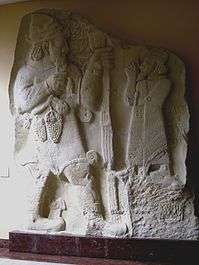Teshub
| Teshub | |
|---|---|
|
Teshub (left) being worshipped by king Warpalawas of Tyana | |
| Other names | Tarhun, Tarhunt, Tešup, Tarhunzas[1] |
| Spouse(s) |
Hebat Arinniti |
| Children | Sarruma and Inara |
| Parent(s) | Enlil or Anu's genitals eaten by Kumarbi |
| Relatives |
Anu (grandfather) Anshar (great-grandfather) Tigris (brother) Tashmishu (brother) Ullikummi (half-brother according to some versions) |
Teshub (also written Teshup or Tešup; cuneiform dIM; hieroglyphic Luwian (DEUS)TONITRUS, read as Tarhunzas[1]) was the Hurrian god of sky and storm. Taru is the Hattian form derived from Teshub.[2] His Hittite and Luwian name was Tarhun (with variant stem forms Tarhunt, Tarhuwant, Tarhunta), although this name is from the Hittite root *tarh- "to defeat, conquer".[3][4]
Depiction and myths

Teshub is depicted holding a triple thunderbolt and a weapon, usually an axe (often double-headed) or mace. The sacred bull common throughout Anatolia was his signature animal, represented by his horned crown or by his steeds Seri and Hurri, who drew his chariot or carried him on their backs.
Family
The Hurrian myth of Teshub's origin—he was conceived when the god Kumarbi bit off and swallowed his father Anu's genitals, similarly to the Greek story of Uranus, Cronus, and Zeus, which is recounted in Hesiod's Theogony. Teshub's brothers are Aranzah (personification of the river Tigris), Ullikummi (stone giant) and Tashmishu.
In the Hurrian schema, Teshub was paired with Hebat the mother goddess; in the Hittite, with the sun goddess Arinniti of Arinna—a cultus of great antiquity which has similarities with the venerated bulls and mothers at Çatalhöyük in the Neolithic era. His son was called Sarruma, the mountain god.
Illuyanka
According to Hittite myths, one of Teshub's greatest acts was the slaying of the dragon Illuyanka.
Myths also exist of his conflict with the sea creature (possibly a snake or serpent) Hedammu (CTH 348).
